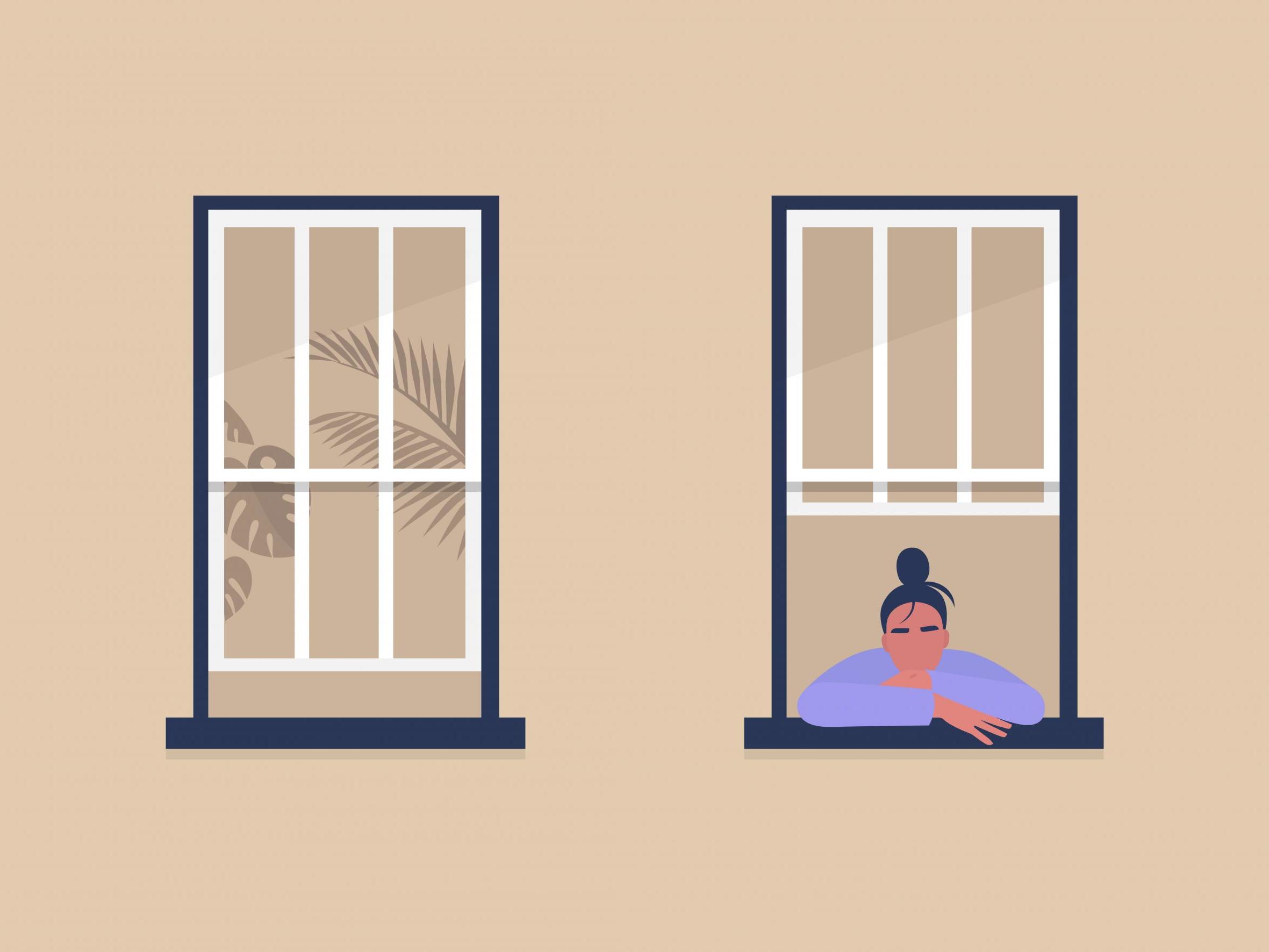‘This is a bad dream for many but for me, the isolation could continue for years’: People with chronic illness on spending extended time at home
Since the start of the lockdown, many with chronic illness have been frustrated by a narrative that excludes their experiences of long-term social isolation. Sophie Gallagher talks to them


Holly Clarke hates the film Ferris Bueller’s Day Off. It reminds the 22-year-old of missing the whole of secondary school, having her friends constantly tell her how “lucky” she was never to have to attend class and instead, spending all day in bed because of her ME (myalgic encephalomyelitis), which she contracted after having childhood meningitis. “All I ever wanted to do was go out, go to school, live normally,” she says.
Clarke, who lives in Manchester, would only get out for things like a supermarket trip with her family. The amount of time she spent inside could stretch on for months at a time especially when her symptoms (fatigue, muscle aches, poor sleep, nausea and headaches) were bad. “I had to find joy in the small stuff, a song, daffodils on my windowsill, a letter from a friend because when I was forced into isolation, the rest of the world wasn’t isolating with me.”
Around 250,000 Brits have ME, according to charity Action For ME. A further 28 million people in the UK live with general chronic pain and an estimated 15 million (about 23 per cent of people) have at least one chronic or long-term health condition. Of course not all of these people will be housebound, but many will experience symptoms that sometimes makes leaving the house difficult, curtails their ability to have an active social life or commit to plans far in advance.
Since Boris Johnson implemented a nationwide coronavirus lockdown on 23 March (now extended until at least 7 May) many people have been sharing their difficulty and frustration with being trapped at home, their autonomy to decide when to go out taken away by the government. Although this is understandable, not least given the context of a global pandemic and rising death toll, for some with chronic illness the response has highlighted how many normally overlook the plight of the long term unwell or disabled.
“Welcome. This is how lots of people have to live in ‘normal life’ too,” Joseph Post, 26, from Leicester, who also has ME tells The Independent. Since lockdown, Post has been frustrated with friends who are often dismissive about his frustrations – “they normally tell me they’re jealous I get to watch Netflix when they’re at work if I try to talk about how lonely I am” – now saying that “their human rights are being infringed” by not being able to sunbathe in the park.
“I’m obviously not relishing in everyone being in this position but I do hope when everything returns to ‘normal’ that people remember those who have to live life this way 24/7,” he adds.
The longest unbroken period of time Tamsyn Martin, 30, from Cornwall, has spent at home is four months. For the last five years the majority of Martin’s time has been housebound, if not totally bedridden, living in a specially-built annexe in her parent’s garden.
About 90 per cent of my life is spent away from other people...”
Martin has mast cell activation syndrome (MCAS) which causes mast cells to release chemicals causing pain, chronic fatigue and in the worst cases, anaphylaxis. Triggers for sufferers can include heat, cold, smells, exercise, stress and some foods. Also for Martin, pollen. She also has erythromelalgia (burning pain across the body that can be so severe it makes sleeping and walking difficult).
“About 90 per cent of my life is spent away from other people,” she says. “I have to live in a hypoallergenic environment with three air purification systems: one brings in filtered air from outside as opening windows could allow in pollen, smoke or other pollutants that could cause a life threatening allergic reaction. My parents bring me food and medication.”
In the summer Martin’s days are spent in the dark in her bedroom as she is also heat intolerant and photosensitive. “In winter I can leave home a little more to go to the beach – I can safely breathe sea air without a mask – but I tire so quickly I go home.” She spends her time reading, talking on the internet, watching films and exploring the world via YouTube vlogs.
“For a lot of people, after this situation is over, their lives will become more ‘normal’ again, this will be somewhat of a bad dream. For many of us, the isolation will continue for months or even years. I hope that people are getting at least a small amount of insight,” she explains.
Vivien Green, 38, from Linlithgow in Scotland, who has had a life-long sleeping disorder, which means she sleeps at hours that are incompatible with most people, agrees. “This period of enforced lockdown is making others feel the frustrations of not being able to do what they want to do and having to find contentment in a more restricted life,” she says.
But Kirsty Hampson, 30, from Somerset who was diagnosed with endometriosis in 2017 – a condition which the NHS says is when tissue similar to the lining of the womb grows in other places like the ovaries, causing chronic pain, fatigue and other symptoms – says many people are still only experiencing a fraction of what people with chronic illness endure.
“I’m seeing a lot of people saying how hard it is to stay inside and not see friends and family but for disabled and chronically ill people, this is our life,” she explains. “We miss out on special events, we don’t get to see our friends as often, we spend days in bed because we can’t physically move, we feel exhausted after 10 hours of sleep.”
Hampson, who had to quit her job at a pre-school in 2018 because of her endometriosis, adds that for many people with an illness being at home is still harder because they might not be able to leave the house for a short walk or exercise (government guidelines still permit this along with buying food, medication or travelling to work as a key worker).
Think of those who experience this kind of frustration and loneliness on a daily basis for years and years, not just a few months...”
“I still feel like people don’t really get it, they aren’t making that link,” she says. “People can also still go out for daily exercise, and sometimes I’m not able to do that. Even though they don’t feel like it, they still have that aspect of freedom that we don’t.”
She also says that with the coronavirus lockdown people know restrictions will be eased at some point, even if they don’t have a fixed date. For people with illness, it can be a life-long lockdown. “Think of those who experience this kind of frustration and loneliness on a daily basis for years and years, not just a few months,” she adds.
Jen Wilson, 41, from Glasgow, says people who are well at home, just self-isolating, don’t have this additional strain of an illness as well as the emotional and mental impact.
Wilson has Crohn’s disease (a type of inflammatory bowel disease). During her worst flare ups she doesn’t have enough energy to stand in the shower, needs crutches to get from the bedroom to the toilet and can’t even lift the kettle to make tea. She also has to be wary of who she socialises with as she is on immunosuppressant drugs so cannot risk being near people who are, or have recently been, unwell.
“Spending all day on your own in the house is hard going,” she says. “When you are the one that isn’t well and stuck inside and everyone else is busy, it can be easy to be forgotten about by everyone other than your carers. In light of recent times and people going into lockdown, many of my friends have a tiny insight into how hard it is.”
Although many in the chronic pain community are finding the response difficult to navigate, many hope lockdown will increase compassion for people who have to do so in future. Wilson says: “All of my friends have made a promise that if I have another flare or get sick that we will make sure that we keep in contact better. In many respects we are all learning compassion.”
Martin hopes the situation will make things better because people have been forced to see what it is like for themselves, rather than just listen to experiences. “I truly hope that this situation brings a change for those of us who have to spend our lives inside, I hope it helps other people to understand and that understanding influences the way we are treated by society, the government and medical professionals,” she says.
As European countries like Germany and Denmark begin to lift social distancing rules, re-open shops and schools, the UK is expected to follow suit in the coming months.
Whether this happens quickly or is a phased return that sees several stages of exit, we know there is hope on the lockdown horizon for many of us. And now, for those with chronic conditions that can keep them indoors much of their lives, perhaps small comfort in knowing that finally, others are able to empathise albeit in a small way.
Join our commenting forum
Join thought-provoking conversations, follow other Independent readers and see their replies
Comments